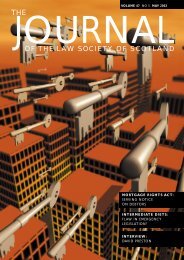Coulsfield reports civil justice as ripe for review Coulsfield reports ...
Coulsfield reports civil justice as ripe for review Coulsfield reports ...
Coulsfield reports civil justice as ripe for review Coulsfield reports ...
You also want an ePaper? Increase the reach of your titles
YUMPU automatically turns print PDFs into web optimized ePapers that Google loves.
is going to rise by 2010 from 50 to<br />
55, retirement will be more flexible<br />
and can be combined with carrying<br />
on working or be on a ph<strong>as</strong>ed b<strong>as</strong>is.<br />
■ voluntary contributions require to<br />
be <strong>review</strong>ed.<br />
■ the position of high earners<br />
requires particular attention.<br />
■ there is a lot of planning<br />
needing done:<br />
– financial planning to get the best<br />
out of the rules, whether that h<strong>as</strong><br />
to be done be<strong>for</strong>e or after A-Day;<br />
– administrative planning to ensure<br />
that the system can handle the<br />
new regime and also store<br />
historical data, which will still be<br />
needed in future; and that staff<br />
have the knowledge and training<br />
to implement.<br />
Pensions Act 2004<br />
Significant parts of the Act came<br />
into <strong>for</strong>ce on 6 April 2005, with<br />
some parts intended to come in<br />
later, particularly April 2006.The<br />
p<strong>as</strong>t period h<strong>as</strong> been one of<br />
constant consultations over draft<br />
www.journalonline.co.uk<br />
regulations, the making of<br />
regulations and consultations over<br />
draft codes of practice.<br />
The next part of this article looks at<br />
some of the significant<br />
developments following the coming<br />
into <strong>for</strong>ce of the Act.<br />
Corporate transactions<br />
There have been a number of issues<br />
on defined benefit schemes which<br />
have a major effect in relation to<br />
corporate transactions, although<br />
these also affect companies even<br />
when not having transactions and in<br />
particular affect the trustees.<br />
Following scheme wind-up or on<br />
withdrawal from a scheme, an<br />
employer can become liable <strong>for</strong> a<br />
statutory debt of (or of its share of)<br />
any deficit. Initially this w<strong>as</strong> me<strong>as</strong>ured<br />
by the now discredited minimum<br />
funding requirement (MFR), which in<br />
fact might provide <strong>as</strong> little <strong>as</strong> 40% of<br />
the amount required to purch<strong>as</strong>e<br />
annuities to cover the benefits.This<br />
w<strong>as</strong> changed <strong>for</strong> schemes winding<br />
up after 11 June 2003 by the<br />
Occupational Pension Schemes<br />
(Winding Up and Deficiency on<br />
Winding Up etc) (Amendment)<br />
Regulations 2004 (SI 2004/403),<br />
which applied on a total winding up<br />
with the employer solvent. Creeping<br />
amendments culminating in the<br />
Occupational Pension Schemes<br />
(Employer Debt etc) (Amendment)<br />
Regulations 2005 (SI 2005/2224),<br />
now also catch partial<br />
discontinuances, on or after 2<br />
September 2005.<br />
The net effect of this is that the<br />
deficiency is now me<strong>as</strong>ured not on<br />
the MFR b<strong>as</strong>is but on the horrifying<br />
annuity purch<strong>as</strong>e b<strong>as</strong>is.<br />
Not only that, but the legislation h<strong>as</strong><br />
some bizarre turns.Where all<br />
employers ce<strong>as</strong>e involvement, the<br />
date <strong>for</strong> <strong>as</strong>sessment of the<br />
deficiency is “the applicable time”<br />
selected by the trustees.Where one<br />
employer discontinues and another<br />
carries on, the applicable time <strong>for</strong><br />
<strong>as</strong>sessing the deficit is the date<br />
when the ce<strong>as</strong>ing employer ce<strong>as</strong>es<br />
to have employees in the category<br />
of employment to which the<br />
scheme relates. It will be seen that<br />
that is a rather unhelpful definition<br />
and can cause some bizarre results,<br />
<strong>for</strong> example where the l<strong>as</strong>t member<br />
of a scheme section with one of<br />
several employers just dies.<br />
Subject to requirements in the<br />
regulations (including Regulator<br />
approval), it is open to the parties,<br />
including the trustees, to agree that<br />
the deficit will be shared differently.<br />
The requirements <strong>for</strong> this are set<br />
out in the 2005 Regulations.<br />
In the April article it w<strong>as</strong> pointed<br />
out that the Pension Protection<br />
Fund is itself sought to be protected<br />
by various provisions.To stop<br />
corporate “jiggery pokery” there are<br />
so-called “moral hazard” provisions<br />
in the <strong>for</strong>ms particularly of<br />
contributions notices and financial<br />
support directions, which could<br />
enable the Regulator to require<br />
contributions or other payments<br />
from employers or other connected<br />
persons (including indeed individual<br />
shareholders) who are seeking to<br />
escape a deficit. Clearly this h<strong>as</strong> very<br />
significant and indeed frightening<br />
<strong>as</strong>pects <strong>for</strong> corporate transactions.<br />
The Journal: December 2005 : 23










